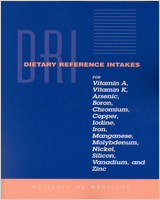
NCBI Bookshelf. A service of the National Library of Medicine, National Institutes of Health.
| Sex/Age Categorya | Number of Persons Examined | Mean | Percentile | |
|---|---|---|---|---|
| 5th | 10th | |||
| Both sexes, 2 to 6 mo | 793 | 457 | 0 | 0 |
| Both sexes, 7 to 12 mo | 827 | 790 | 60 | 98 |
| Both sexes, 1 to 3 y | 3,309 | 927 | 159 | 217 |
| Both sexes, 4 to 8 y | 3,448 | 1,277 | 530 | 616 |
| Standard error | 93 | 24 | 32 | |
| M 9 to 13 y | 1,219 | 1,330 | 674 | 770 |
| Standard error | 68 | 30 | 38 | |
| M 14 to 18 y | 909 | 1,418 | 693 | 801 |
| Standard error | 84 | 39 | 45 | |
| M 19 to 30 y | 1,902 | 2,032 | 881 | 1,040 |
| Standard error | 353 | 71 | 95 | |
| M 31 to 50 y | 2,533 | 2,192 | 929 | 1,097 |
| Standard error | 151 | 57 | 70 | |
| M 51 to 70 y | 1,942 | 2,264 | 880 | 1,046 |
| Standard error | 110 | 29 | 36 | |
| M 71+ y | 1,255 | 2,088 | 788 | 937 |
| Standard error | 132 | 44 | 52 | |
| F 9 to 13 y | 1,216 | 1,280 | 569 | 668 |
| Standard error | 306 | 72 | 70 | |
| F 14 to 18 y | 949 | 1,162 | 448 | 526 |
| Standard error | 102 | 34 | 37 | |
| F 19 to 30 y | 1,901 | 1,704 | 532 | 645 |
| Standard error | 243 | 19 | 30 | |
| F 31 to 50 y | 2,939 | 2,013 | 690 | 848 |
| Standard error | 102 | 32 | 39 | |
| F 51 to 70 y | 2,065 | 1,960 | 691 | 840 |
| Standard error | 96 | 24 | 29 | |
| F 71+ y | 1,368 | 1,921 | 675 | 817 |
| Standard error | 108 | 26 | 33 | |
| Pregnant | 346 | 1,455 | 649 | 754 |
| Standard error | 132 | 50 | 60 | |
| Lactating | 99 | 1,850 | 958 | 1,098 |
| Standard error | 277 | 144 | 171 | |
| All Individuals | 28,575 | 1,719 | 583 | 714 |
| Standard error | 49 | 13 | 16 | |
| All Indiv (+P/L) | 29,015 | 1,712 | 581 | 712 |
| Standard error | 44 | 11 | 14 | |
NOTE: Data are limited to individuals who provided a complete and reliable 24-hour dietary recall on day 1. The intake distributions for 2–6 months, 7–12 months, and 1–3 years of age are unadjusted. Means and percentiles for these groups were computed using SAS PROC UNIVARIATE. For all other groups, data were adjusted using the Iowa State University method. Mean, standard errors, and percentiles were obtained using C-Side. Standard errors were estimated via jackknife replication. Each standard error has 49 degrees of freedom. Food composition data are from the NDS-R Food and Nutrient Database, Version 30, 1999, Nutrition Coordinating Center, University of Minnesota. Infants and children fed human milk and females who had “blank but applicable” pregnancy and lactating status data or who responded “I don't know” to questions on pregnancy and lactating status were excluded from all analyses. Females who were both pregnant and lactating were included in both the Pregnant and Lactating categories. The sample sizes for the Pregnant and Lactating categories were very small so their estimates of usual intake distributions are not reliable.

NCBI Bookshelf. A service of the National Library of Medicine, National Institutes of Health.